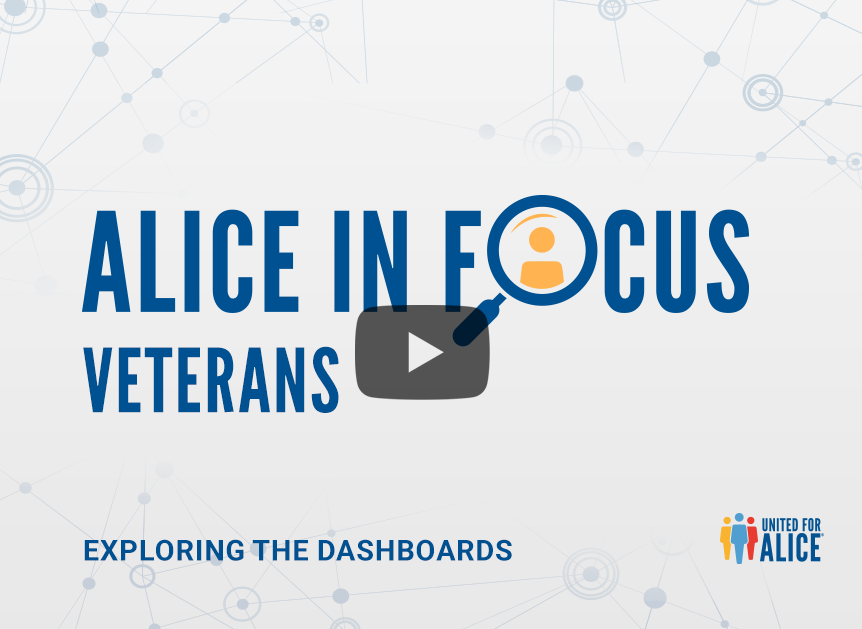
Research Center
ALICE In Focus Series
Veterans in Financial Hardship
Because U.S. military veterans have served and sacrificed for this country, there is a national sense of responsibility to ensure that their basic needs are met. And overall, veterans have fared better economically than nonveterans. Yet not everyone has been included in that trend: In 2019, a substantial 4.6 million veterans — 27% — still struggled to make ends meet across the U.S.
According to the outdated Federal Poverty Level (FPL), 6% of veterans in the U.S. lived in poverty in 2019. But United For ALICE data shows that another 21% — more than three times as many — were also struggling, in households that earned above the FPL but less than what it costs to afford the basics. These households are ALICE: Asset Limited, Income Constrained, Employed.
Combining families in poverty and those who are ALICE, more than one-quarter (27%) of all veterans lived in a household with income below the ALICE Threshold in 2019, struggling to afford essentials in the communities where they lived.
The tabs below offer a more detailed view of veterans experiencing financial hardship.
ALICE Veterans Data Dashboard
The ALICE Veterans Data Dashboard puts the data about veterans who are experiencing financial hardship at your fingertips. The Dashboard shows the number and percentage of veterans in 2019 who lived in households with:
- Income below the Federal Poverty Level (Poverty)
- Income above the Federal Poverty Level but below what is needed to afford the cost of basic expenses (ALICE)
- Income above the cost of basics (Above ALICE Threshold)
Veterans below the ALICE Threshold include both those in poverty and those in ALICE households.
With the first Dashboard tool, you can explore the data on veterans by category, including age, sex, race/ethnicity, disability status, educational attainment, service era, work status, and more.
How to Use This Tool
- Select an ALICE Partner State or select 'U.S.' to see national data
- Select a Category (like Age, Race/Ethnicity, or Disability Status)
- Hover over the bar graph to see the number and percentage of veterans in each group
- View the table below the bars to see the number of veterans in each group
With the second Dashboard tool, you can combine categories (such as veterans who are 25–44 years old, Black, and have a disability).
How to Use This Tool
- Select an ALICE Partner State or select 'U.S.' to see national data
- Use the drop-down menus to select variables across different categories (like “Age 25–44,” “Black,” and “With a Disability”)
- The pie chart will change based on your selections to show the percentage and number of veterans in the selected groups who are in poverty-level, ALICE, or Above ALICE Threshold households.
Technical Details
- Sources: ALICE Threshold, 2019; U.S. Census Bureau, American Community Survey, PUMS, 2019 (latest available as of publication date)
- Rounding: Percentages are rounded to whole numbers for ease of reading, which may result in percentages totaling 99% or 101%. Percentages in the ALICE Veterans Data Dashboard may differ +/- 1% from percentages included in the state and national Research Briefs due to rounding. Total numbers are presented in the Dashboard for calculation.
- Race/Ethnicity: All racial categories except Two or More Races are for one race alone, non-Hispanic. The Hispanic group may include veterans of any race.
- Sex: Sex includes the sex reported by the respondent for household members; the ACS only includes the options "male" or "female."
- Education: The Educational Attainment category is based on the highest level of educational attainment and includes veterans age 25 and older.
- Work Status: The Work category includes veterans age 17–64.
- Selected Variables: All variables in this Dashboard come from the American Community Survey. To see how these variables are defined and named in this Dashboard, download the DATA DICTIONARY
- Missing Data and Grand Totals: Any group with fewer than 200 veterans is suppressed (not shown) to maintain accuracy and confidentiality. Grand totals exclude any sub-populations that are too small to display (sums in columns).

